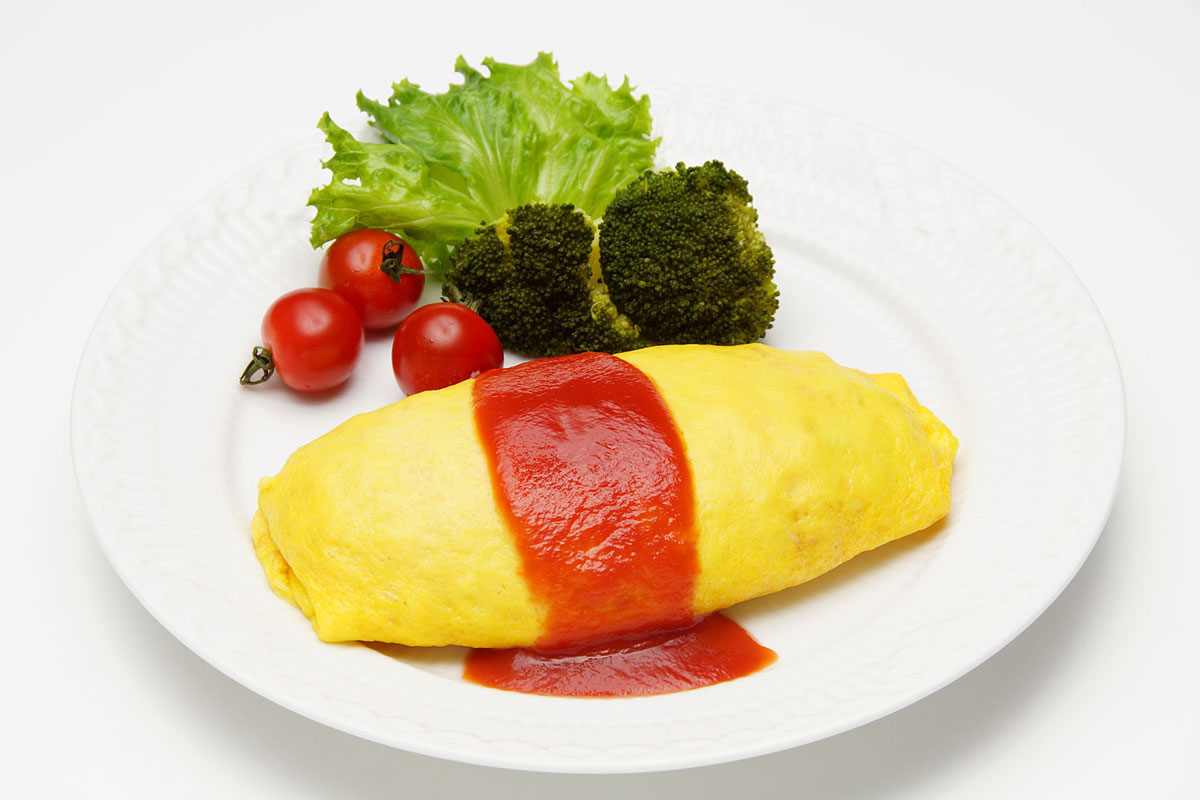

OMURAISU – A RICE OMELETTE THAT NOT ONLY CHILDREN WILL LIKE
What is omuraisu?
The name omuraisu is an example of wasei-eigo, that is, the creation of Japanese words derived from English ones. It was created by combining the words omelette (omu) and rice (raisu). Alternatively, soba noodles may sometimes be used instead of rice. Such a dish is called omusoba.
Omuraisu is an omelette made with fried rice. However, the additional ingredients of the dish, which are fried with the rice, are not strictly defined. Most importantly, different types of meat (for example chicken, pork or beef), as well as vegetables, with the most popular ones being carrots, onions, sugar snap peas, mushrooms and peppers, may be used in the dish. The omelette can be prepared in various ways – it may be thin and completely cover the rice, or fluffier and moister.
The fried rice and the toppings are placed on the omelette, which is then folded in half, thereby covering the whole filling. When transferring the dish from a pan to a plate, one should try to form it into a spindle-like shape. The dish is then topped with ketchup or demi-glace sauce, which it is often squeezed out of the bottle in such a way as to form a kanji – a lithographic sign which is an element of the Japanese script.
Omuraisu is a very filling dish that is popular and well-liked among the Japanese. It is usually served for breakfast. It may be encountered in Japanese homes, school canteens and restaurants alike.
Eggs in the Japanese culinary tradition
Eggs are a product that is very often consumed in Japan, both in sweet and savoury form. Since some recipes recommend leaving the egg in a semi-liquid form, a best- before date for ingesting raw eggs is often included on the packaging. In summer, these time limits are much shorter (about two weeks) but in winter they are usually longer (up to two months).
Omuraisu recipe
Though the omuraisu version proposed by us is based on chicken, onions, mushrooms and peas, as mentioned before, these additions can be freely modified. The amount of ingredients indicated below will allow you to prepare two portions of the dish.
Cook 1 glass of short grain rice in salted water, then drain it and leave it until it has cooled completely. Break 6 eggs and mix them in a bowl, add salt, then leave the mixture for now. Dice 1 spring onion into fine cubes. Dice 100 grams of skinless chicken meat (thighs or drumsticks will be the best for this purpose, as that is the most delicate and juicy kind of meat) into slightly larger cubes. Slice a handful of mushrooms. Place one tablespoon of any fat on a wide pan, then add the onion and meat and fry them. Add mushrooms and a handful of frozen peas. Then, add the rice and a tablespoon of butter. Fry the mixture and season it with pepper and salt. After the rice has been fried, put it on the plates.
Heat up a teaspoon of oil on a small (max. 20 cm in diameter), Teflon frying pan, then pour half of the egg mixture into the pan. Next, use chopsticks to stir the mixture vigorously for a few seconds – thanks to this, the interior of the omelette will be fluffy and moist. Stop mixing once the eggs begin to congeal. Then, place the filling on one half of the semi-liquid omelette and use a spatula to fold the omelette in half, so that the empty side covers the stuffing. This whole operation needs to be conducted very quickly – we cannot allow the omelette to congeal completely – the inside should still remain slightly liquid. We can now prepare the second portion of the dish in the same way. Finally, place the omelettes on a plate and pour ketchup on top of them.
At first, folding the omelette containing the filling while it is still on the frying pan may cause problems, but with time and practice it will certainly become much easier. Of course, it is also possible to make the whole ordeal slightly easier and serve the omelette and the stuffing separately or put the filling inside of the omelette once it has been put on a plate.


















